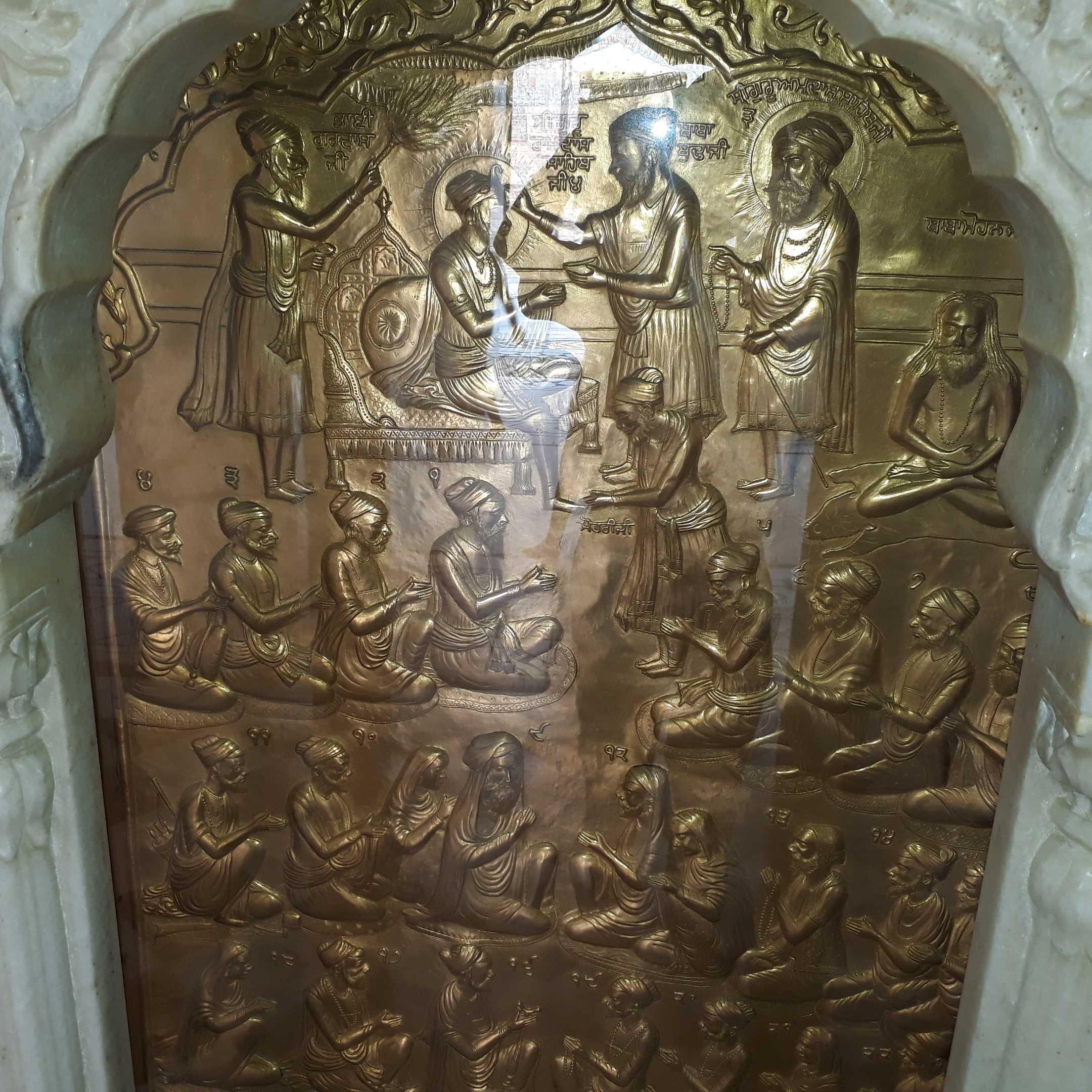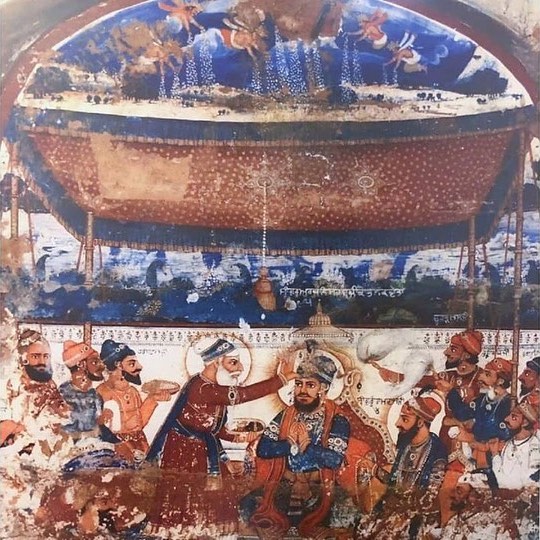|
Masand
A masand was a representative and tithe collector in Sikhism. They were an officially appointed missionary minister representing the Sikh Guru, who baptized conversions to Sikhism, and collected '' dasvandh'' ("the tenth" of income) as an offering to the Sikh community and religious establishment. A masand forwarded the collected amount to the Sikh guru. Etymology The word masand (Punjabi: ਮਸੰਦ) is an adaptation of the Persian term ‘masnad’ (Punjabi: ਮਸਨਦ), which refers to ‘a seat’ that is at a lower level than the throne. The Guru was the highest authority while masands were emplaced to spread the message of Sikhism and given the authority to baptize individuals converting to Sikhism. During conversions happening in the absence of the Guru, the new convert would touch the feet of the masand or drink the water they had dipped their toe in, in order to become initiated into the Sikh religion. History: Origin and Structure It is unclear when the m''asa ... [...More Info...] [...Related Items...] OR: [Wikipedia] [Google] [Baidu] |
Guru Ram Das
Ram Das (Gurmukhi: ਗੁਰੂ ਰਾਮ ਦਾਸ, pronunciation: ; 24 September 1534 – 1 September 1581) was the fourth of the ten Gurus of Sikhism. He was born in a family based in Lahore. His birth name was Jetha, and he was orphaned at age seven; he there after grew up with his maternal grandmother in a village. At age 12, Bhai Jetha and his grandmother moved to Goindval, where they met Guru Amar Das. The boy thereafter accepted Guru Amar Das as his mentor and served him. The daughter of Guru Amar Das married Bhai Jetha, and he thus became part of Guru Amar Das's family. As with the first two Gurus of Sikhism, Guru Amar Das instead of choosing his own sons, chose Bhai Jetha, owing to Bhai Jetha's exemplary service, selfless devotion and unquestioning obedience to the commands of the Guru, as his successor and renamed him as Ram Das or "servant of god." Guru Ram Das became the Guru of Sikhism in 1574 and served as the 4th guru until he gave up his body to ... [...More Info...] [...Related Items...] OR: [Wikipedia] [Google] [Baidu] |
Sikh Manji
A Manji (Punjabi: ਮੰਜੀ ਪ੍ਰਥਾ ) was a Sikh religious administrative unit for the propagation of Sikhism towards men. It was part of the Sikh missionary administrative organization founded by Guru Amar Das, the third Guru of Sikhism. Manji refers to each zone of religious administration with an appointed chief called ''sangatias'', with officially appointed representatives known as a ''masand''. It had been conceptually similar in its aims to the diocese system in Christianity, and had been similarly important in Sikh missionary activity. The word ''Manji'' or ''Manja'' literally means a cot (taken as the ''seat of authority'' in this context). A similar administrative unit existed for women. It was known as a Piri and was part of the Piri system. Guru Amar Das divided the Sikh congregation areas into twenty-two Manjis. He appointed a local preacher to be in-charge of each of the Manjis. For this purpose, a large group of 146 followers were trained for the prop ... [...More Info...] [...Related Items...] OR: [Wikipedia] [Google] [Baidu] |
Sikhism
Sikhism (), also known as Sikhi ( pa, ਸਿੱਖੀ ', , from pa, ਸਿੱਖ, lit=disciple', 'seeker', or 'learner, translit= Sikh, label=none),''Sikhism'' (commonly known as ''Sikhī'') originated from the word ''Sikh'', which comes from the Sanskrit root ' meaning "disciple", or ' meaning "instruction". Singh, Khushwant. 2006. ''The Illustrated History of the Sikhs''. Oxford University Press. . p. 15.Kosh, Gur Shabad Ratnakar Mahan. https://web.archive.org/web/20050318143533/http://www.ik13.com/online_library.htm is an Indian religion that originated in the Punjab region of the Indian subcontinent,"Hinduism, Buddhism, Jainism and Sikh originated in India." around the end of the 15th century CE. It is the most recently founded major organized faith and stands at fifth-largest worldwide, with about 25–30 million adherents (known as Sikhs) .McLeod, William Hewat. 2019 998 Sikhism developed from the spiritual teachings of Guru Nanak (1469–1539), the faith's first ... [...More Info...] [...Related Items...] OR: [Wikipedia] [Google] [Baidu] |
Sikh
Sikhs ( or ; pa, ਸਿੱਖ, ' ) are people who adhere to Sikhism (Sikhi), a monotheistic religion that originated in the late 15th century in the Punjab region of the Indian subcontinent, based on the revelation of Guru Nanak. The term ''Sikh'' has its origin in the word ' (), meaning 'disciple' or 'student'. Male Sikhs generally have ''Singh'' ('lion'/'tiger') as their last name, though not all Singhs are necessarily Sikhs; likewise, female Sikhs have ''Kaur'' ('princess') as their last name. These unique last names were given by the Gurus to allow Sikhs to stand out and also as an act of defiance to India's caste system, which the Gurus were always against. Sikhs strongly believe in the idea of "Sarbat Da Bhala" - "Welfare of all" and are often seen on the frontline to provide humanitarian aid across the world. Sikhs who have undergone the '' Amrit Sanchar'' ('baptism by Khanda'), an initiation ceremony, are from the day of their initiation known as Khalsa, and they mu ... [...More Info...] [...Related Items...] OR: [Wikipedia] [Google] [Baidu] |
Guru
Guru ( sa, गुरु, IAST: ''guru;'' Pali'': garu'') is a Sanskrit term for a "mentor, guide, expert, or master" of certain knowledge or field. In pan-Indian traditions, a guru is more than a teacher: traditionally, the guru is a reverential figure to the disciple (or '' shisya'' in Sanskrit, literally ''seeker f knowledge or truth'' or student, with the guru serving as a "counselor, who helps mold values, shares experiential knowledge as much as literal knowledge, an exemplar in life, an inspirational source and who helps in the spiritual evolution of a student". Whatever language it is written in, Judith Simmer-Brown explains that a tantric spiritual text is often codified in an obscure twilight language so that it cannot be understood by anyone without the verbal explanation of a qualified teacher, the guru. A guru is also one's spiritual guide, who helps one to discover the same potentialities that the ''guru'' has already realized. The oldest references to the concep ... [...More Info...] [...Related Items...] OR: [Wikipedia] [Google] [Baidu] |
Dasvandh
Dasvandh ( pa, ਦਸਵੰਧ, also transcribed as daswandh) is the one tenth part (or 10%) of one's income that one should donate, both financially and directly in the form of '' seva'', according to Sikh principles. It falls into Guru Nanak Dev's concept of ''Vand Chhako''. This was done during the time of Guru Arjan Dev and many Sikhs still do it up to this day. The concept of dasvandh was implicit in Guru Nanak's own line: "''ghali khai kichhu hathhu dei, Nanak rahu pachhanahi sei''—He alone, O Nanak, knoweth the way who eats out of what he earneth by his honest labour and yet shareth part of it with others" (GG, 1245). The idea of sharing and giving was nourished by the institutions of sangat (holy assembly) and langar (community kitchen) the Guru had established. History In the time of Guru Amar Das, a formal structure for organising the Sikh religion was developed in order to show directions to the Sikhs by preaching them the teachings of The Holy Guru. He set up 22 ... [...More Info...] [...Related Items...] OR: [Wikipedia] [Google] [Baidu] |
Persian Language
Persian (), also known by its endonym and exonym, endonym Farsi (, ', ), is a Western Iranian languages, Western Iranian language belonging to the Iranian languages, Iranian branch of the Indo-Iranian languages, Indo-Iranian subdivision of the Indo-European languages. Persian is a pluricentric language predominantly spoken and used officially within Iran, Afghanistan, and Tajikistan in three mutual intelligibility, mutually intelligible standard language, standard varieties, namely Iranian Persian (officially known as ''Persian''), Dari, Dari Persian (officially known as ''Dari'' since 1964) and Tajik language, Tajiki Persian (officially known as ''Tajik'' since 1999).Siddikzoda, S. "Tajik Language: Farsi or not Farsi?" in ''Media Insight Central Asia #27'', August 2002. It is also spoken natively in the Tajik variety by a significant population within Uzbekistan, as well as within other regions with a Persianate society, Persianate history in the cultural sphere of Greater Ira ... [...More Info...] [...Related Items...] OR: [Wikipedia] [Google] [Baidu] |
Guru Amar Das
Guru Amar Das (Gurmukhi: ਗੁਰੂ ਅਮਰ ਦਾਸ, pronunciation: ; 5 May 1479 – 1 September 1574), sometimes spelled as Guru Amardas, was the third of the Ten Gurus of Sikhism and became Sikh Guru on 26 March 1552 at age 73. Before becoming a Sikh (Shishya from Sanskrit), on a lovely pilgrimage after having been prompted to search for a ''guru'', he heard his nephew's wife, Bibi Amro, reciting a hymn by Guru Nanak, and was deeply moved by it. Bibi Amro was the daughter of Guru Angad, the second and then current Guru of the Sikhs. Amar Das persuaded Bibi Amro to introduce him to her father and in 1539, Amar Das, at the age of sixty, met Guru Angad and became a Sikh, devoting himself to the Guru. In 1552, before his death, Guru Angad appointed Amar Das as Guru Amar Das, the third Guru of Sikhism. Guru Amar Das was an important innovator in the teachings of Guru who introduced a religious organization called the Manji system by appointing trained clergy, a system th ... [...More Info...] [...Related Items...] OR: [Wikipedia] [Google] [Baidu] |
Guru Arjan
Guru Arjan (Gurmukhi: ਗੁਰੂ ਅਰਜਨ, pronunciation: ; 15 April 1563 – 30 May 1606) was the first of the two Gurus martyred in the Sikh faith and the fifth of the ten total Sikh Gurus. He compiled the first official edition of the Sikh scripture called the Adi Granth, which later expanded into the Guru Granth Sahib. He was born in Goindval, in the Punjab, the youngest son of Bhai Jetha, who later became Guru Ram Das, and Mata Bhani, the daughter of Guru Amar Das. He completed the construction of Darbar Sahib at Amritsar, after the fourth Sikh Guru founded the town and built a sarovar. Guru Arjan compiled the hymns of previous Gurus and of other saints into Adi Granth, the first edition of the Sikh scripture, and installed it in the Harimandir Sahib. Guru Arjan reorganized the Masands system initiated by Guru Ram Das, by suggesting that the Sikhs donate, if possible, one-tenth of their income, goods or service to the Sikh organization ('' dasvandh''). The ''Mas ... [...More Info...] [...Related Items...] OR: [Wikipedia] [Google] [Baidu] |
Aurangzeb
Muhi al-Din Muhammad (; – 3 March 1707), commonly known as ( fa, , lit=Ornament of the Throne) and by his regnal title Alamgir ( fa, , translit=ʿĀlamgīr, lit=Conqueror of the World), was the sixth emperor of the Mughal Empire, ruling from July 1658 until his death in 1707. Under his emperorship, the Mughals reached their greatest extent with their territory spanning nearly the entirety of South Asia. Widely considered to be the last effective Mughal ruler, Aurangzeb compiled the Fatawa 'Alamgiri and was amongst the few monarchs to have fully established Sharia and Islamic economics throughout South Asia.Catherine Blanshard Asher, (1992"Architecture of Mughal India – Part 1" Cambridge university Press, Volume 1, Page 252. Belonging to the aristocratic Timurid dynasty, Aurangzeb's early life was occupied with pious pursuits. He held administrative and military posts under his father Shah Jahan () and gained recognition as an accomplished military commander. Aur ... [...More Info...] [...Related Items...] OR: [Wikipedia] [Google] [Baidu] |
Piri System
The Piri System was part of the Sikh missionary administrative organization founded by the third Sikh guru, Guru Amar Das, for the purpose of propagating Sikhism amongst women. The system was significantly expanded by the seventh Sikh guru, Guru Har Rai. Each Piri was a Sikh missionary seat and administrative unit. A similar Manji system existed for the spread of Sikhism among men. Meaning of ''Piri'' A ''Piri'' is a very small wooden cot (taken as the ''seat of authority'' in this context) from which the Sikh Sikhs ( or ; pa, ਸਿੱਖ, ' ) are people who adhere to Sikhism, Sikhism (Sikhi), a Monotheism, monotheistic religion that originated in the late 15th century in the Punjab region of the Indian subcontinent, based on the revelation of Gu ... ''Piris'' (female Sikh preachers, holders of seat of religious authority) would teach Sikhism to other women. The word Manji also means a wooden cot, similarly used to denote ''seat of Sikh religious authority'' for prea ... [...More Info...] [...Related Items...] OR: [Wikipedia] [Google] [Baidu] |
.jpg)






